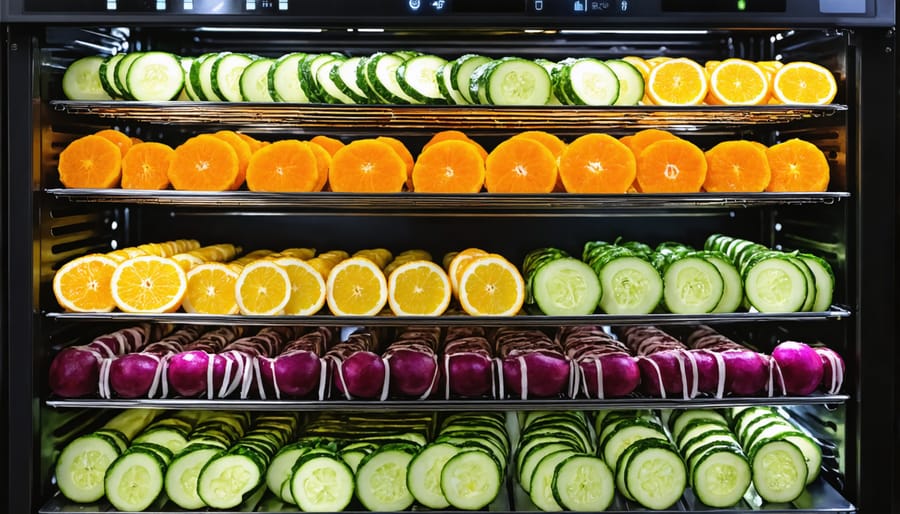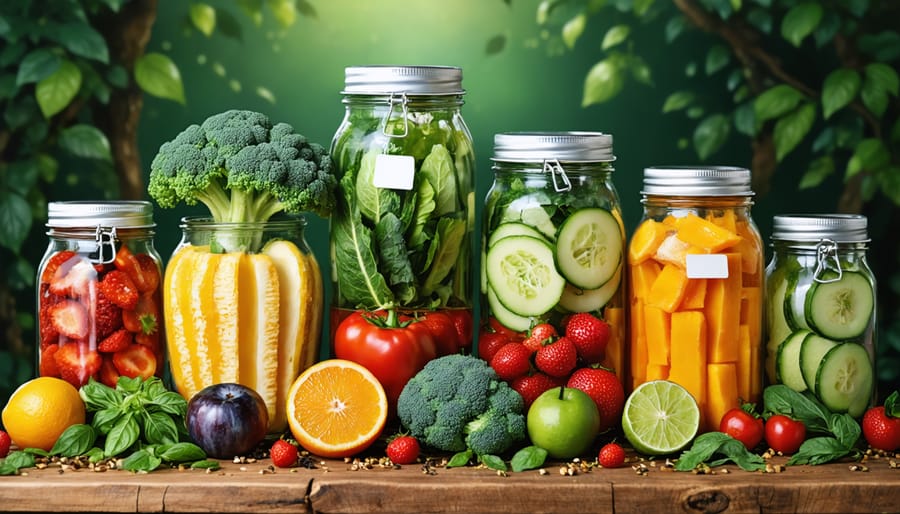Dehydrated Organic Food: Your Secret to Long-Lasting Fresh Flavor
Preserve nature’s bounty while maintaining the full benefits of organic produce through the ancient art of food dehydration. Modern food dehydrators transform fresh organic fruits, vegetables, and herbs into nutrient-dense, shelf-stable ingredients that retain up to 95% of their original nutritional value. This sustainable preservation method eliminates the need for artificial preservatives while reducing food waste and storage space requirements by up to 90%.
Unlike conventional dried foods, dehydrated organic products offer superior flavor concentration and maintain their certification status, making them ideal for year-round access to seasonal organic ingredients. Whether you’re a homesteader looking to preserve your garden’s harvest or an eco-conscious consumer seeking sustainable food storage solutions, dehydration provides a practical bridge between harvest seasons while honoring the integrity of organic farming practices.
From creating nutritious hiking snacks to stocking your pantry with wholesome ingredients, dehydrated organic food represents a perfect fusion of traditional preservation methods and modern sustainable living. This guide explores how to maintain optimal nutritional value while extending the life of your organic investments through proper dehydration techniques.
Why Choose Organic Food Dehydration?
Nutrient Retention in Dehydrated Organic Foods
Dehydrating organic produce stands out among various food preservation methods for its exceptional ability to maintain nutritional value. When done properly, dehydration can retain up to 95% of the food’s original nutrients, making it an excellent choice for preserving organic harvests.
The gentle drying process helps maintain crucial vitamins and minerals while concentrating beneficial compounds. For example, dried organic tomatoes actually contain more lycopene per serving than fresh ones. Similarly, dehydrated organic herbs retain their essential oils and medicinal properties, often becoming more potent in their dried form.
What’s particularly wonderful about dehydration is that it preserves the organic integrity of your produce. Since no chemicals or preservatives are needed, your organic foods stay truly organic. The process simply removes water while leaving beneficial compounds intact, including antioxidants, fiber, and enzymes.
To maximize nutrient retention, it’s important to dehydrate at the right temperature – typically between 95°F and 140°F, depending on the food type. This ensures that heat-sensitive vitamins aren’t destroyed while effectively removing moisture.
Cost-Effective Storage Solution
Dehydrating seasonal organic produce offers a smart way to maximize your food budget while preserving the goodness of peak-season fruits and vegetables. When organic produce is abundant and prices are low, buying in bulk and dehydrating for later use can lead to significant savings. For example, purchasing organic tomatoes during summer harvest can cost 50-60% less than buying them off-season, and dehydrating allows you to enjoy these savings year-round.
The storage efficiency of dehydrated foods also translates to economic benefits. A pound of fresh organic apples reduces to about one-sixth of its original weight when dehydrated, requiring minimal storage space while retaining its nutritional value. This space-saving aspect means you can stock up on organic produce without investing in expensive storage solutions or extra freezer space.
Many home gardeners and small-scale farmers have found success in dehydrating their excess harvest, preventing waste and extending their food supply through leaner months. The initial investment in a quality food dehydrator typically pays for itself within one growing season through preserved organic produce that would otherwise spoil or require costly alternative storage methods.
Best Organic Foods for Dehydration

Fruits and Berries
Dehydrating seasonal organic produce is an excellent way to preserve nature’s sweetness year-round. When dehydrating fruits and berries, proper preparation is key to achieving the best results. Start by selecting ripe, unblemished fruit and washing it thoroughly. Most fruits benefit from a quick lemon juice bath to prevent browning during the drying process.
For apples and pears, slice them uniformly (about ¼ inch thick) and remove the cores. Berries like strawberries should be halved or sliced, while smaller berries such as blueberries can be left whole after checking the skin. Stone fruits like peaches and apricots need to be pitted and cut into even pieces.
Arrange your prepared fruit in single layers on dehydrator trays, ensuring pieces don’t overlap. Most fruits dry best at 135°F (57°C), though times vary significantly: berries typically take 10-18 hours, while apple slices might need 6-12 hours. The fruit is ready when it feels leather-like and pliable, with no moisture when squeezed.
For optimal results, rotate your trays every few hours and check progress regularly. Once dried, let your fruits cool completely before storing in airtight containers. Remember that organic fruits often dry differently than conventional ones due to their natural sugar content and lack of preservatives, so monitoring moisture levels is especially important.
Vegetables and Herbs
Dehydrating organic vegetables and herbs is an excellent way to preserve your garden’s bounty while maintaining nutritional value. Start by selecting fresh, unblemished produce at peak ripeness. Wash thoroughly and cut vegetables into uniform pieces about 1/4 inch thick to ensure even drying.
For leafy greens like kale and spinach, remove tough stems and tear into bite-sized pieces. Root vegetables such as carrots and beets should be sliced thinly or cut into small cubes. Tomatoes can be halved or sliced, while mushrooms are best cut into 1/4-inch slices.
Herbs require special attention due to their delicate nature. Remove stems and spread leaves in a single layer. Popular herbs for dehydrating include basil, oregano, thyme, and sage. These can be dried at lower temperatures (95°F to 105°F) to preserve their essential oils and flavors.
Pre-treatment isn’t always necessary for vegetables, but blanching can help maintain color and reduce drying time. For best results, maintain a consistent temperature between 125°F and 135°F for vegetables. Your produce is ready when it’s crisp and brittle – a process that typically takes 6-12 hours depending on the item and humidity levels.
Store your dehydrated vegetables and herbs in airtight containers away from direct sunlight. When properly dried and stored, they can last up to a year while retaining their organic integrity and most of their nutritional benefits.
Essential Equipment and Techniques
Choosing Your Dehydrator
Selecting the right dehydrator is crucial for successfully preserving your organic produce. Start by considering the size you’ll need – a smaller 5-tray model works well for occasional use, while larger 9-12 tray units are perfect for homesteaders processing seasonal harvests. Look for adjustable temperature controls, which allow you to safely dry different types of produce at their optimal temperatures.
For organic food preservation, stainless steel trays are worth the investment over plastic ones. They’re more durable, easier to clean, and won’t leach chemicals into your food. A model with a timer and automatic shut-off can prevent over-drying and save energy.
Consider the airflow system – horizontal flow dehydrators typically provide more even drying than vertical models. Also check the noise level, especially if you’ll be running it in shared living spaces. Many modern dehydrators feature quiet operation without sacrificing performance.
Budget-friendly options start around $50, while premium models can reach $300 or more. Remember that a quality dehydrator is an investment that will help you preserve organic produce for years to come.

Natural Sun-Drying Methods
Natural sun-drying is one of humanity’s oldest and most sustainable methods of food preservation. This traditional technique harnesses solar energy and natural airflow to slowly remove moisture from organic produce, helping preserve its nutrients and flavors. The process begins by selecting fully ripe, unblemished organic fruits, vegetables, or herbs.
To sun-dry effectively, choose a location that receives direct sunlight for at least 6-8 hours daily and has good air circulation. Place your prepared produce on drying racks or screens, ideally elevated about 6 inches off the ground. Traditional materials like bamboo or wood work well, though modern food-grade mesh screens are also suitable.
Many Mediterranean cultures still practice sun-drying tomatoes, figs, and herbs on their rooftops or in dedicated drying yards. The key is to cover the produce with breathable mesh to protect it from insects while allowing moisture to escape. Depending on your climate and the type of produce, drying times can range from 2-14 days.
For best results, bring your produce indoors at night to prevent moisture reabsorption, and continue the process the next day until the desired dryness is achieved.

Storage and Usage Tips
Proper storage is crucial for maintaining the quality and shelf life of your dehydrated organic foods. Using proper storage containers like airtight glass jars, food-grade mylar bags, or vacuum-sealed containers will protect your preserved goods from moisture and light exposure.
Store your dehydrated foods in a cool, dark place with temperatures between 50-60°F (10-15°C). A pantry or basement shelf works perfectly, but avoid areas near stoves or heating vents. Consider using oxygen absorbers in your storage containers to prevent oxidation and extend shelf life.
When using dehydrated foods, remember they’re concentrated versions of their fresh counterparts. Start by rehydrating smaller portions to avoid waste. Most items will reconstitute within 30 minutes to 2 hours in warm water. For faster results, use hot (not boiling) water and reduce soaking time by half.
Here’s a helpful tip from our community garden: label each container with the contents and drying date. While properly stored dehydrated organic foods can last 1-2 years, it’s best to rotate your stock and use older items first.
To maintain freshness after opening, ensure container lids are tightly sealed and check periodically for any signs of moisture or mold. If you notice any off-odors or visible mold, discard the affected items immediately. For frequently used items, consider storing smaller portions in separate containers to minimize exposure to air and moisture when accessing your preserved foods.
Dehydrating organic produce offers an excellent way to preserve the bounty of your garden or local farmer’s market while maintaining the nutritional benefits and clean eating principles you value. By removing moisture while keeping vital nutrients intact, you’re creating shelf-stable foods that retain their organic integrity without artificial preservatives or additives.
As we’ve explored throughout this guide, food dehydration is both an art and a science that’s accessible to everyone. Whether you’re starting with simple fruits and vegetables or advancing to more complex recipes, the possibilities are endless. The initial investment in a quality dehydrator and some basic knowledge can lead to significant savings while reducing food waste and maintaining a year-round supply of organic snacks and ingredients.
We encourage you to start your dehydrating journey with easy projects like apple chips or kale crisps. As your confidence grows, experiment with different temperatures, timing, and combinations to create your signature dried treats. Remember that practice makes perfect, and even small batches can yield delicious results. By dehydrating your organic produce, you’re not just preserving food – you’re preserving the essence of sustainable, healthy living.

